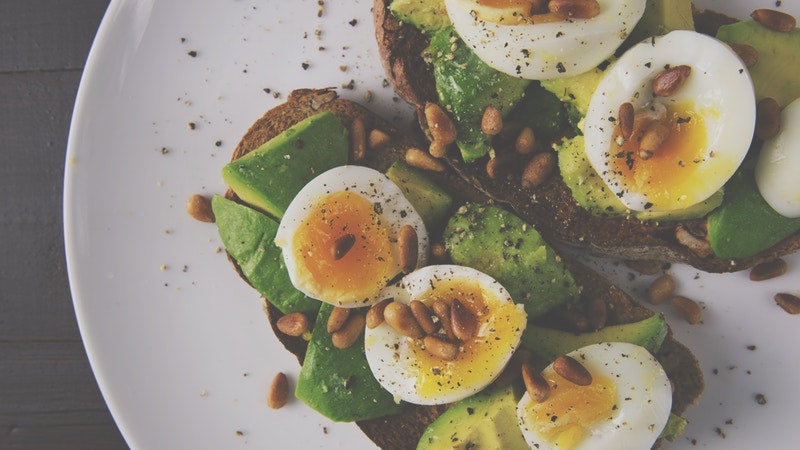Why Low-Carb?
Episode #1 of the course Basics of low-carb eating by Emily Stone
Welcome to the course!
I’m Emily, a lifelong questioner who refuses to accept that our current way of eating and “dieting” is the best we can do. Cleveland Clinic’s Dr. Mark Hyman states that one in two Americans has pre-diabetes or type-2 diabetes, and for children, it’s one in four. That is not the reality I want for my family (or anyone), so I’m spreading the word—forget what you think you know about eating low-fat or “eat less/exercise more,” and open your mind to a more research-based and effective approach (that’s still delicious!): low-carb, high-fat.
First, we’ll focus on why certain foods make us fat, while others burn fat, reduce inflammation, and increase overall health. By the end of the course, you’ll be armed with recipes and tips for eating low-carb, high-fat—from breakfast to dessert.
Why Blame (Some) Carbs?: A Mini Science Lesson
When any carb-containing food (bread, apple, candy) gets digested by the body, it’s turned into glucose, which enters the bloodstream as blood sugar. A high-fiber carb (like broccoli) will be digested slowly, so there is a steady stream of sugar released into the blood, and it can be used by all the body’s cells for fuel.
However, low-fiber carbs (like a doughnut) are digested very quickly, sending a rush of sugar into the blood. As a protective measure, the body releases insulin to remove this excess blood sugar. Insulin stores the sugar in fat cells before the rest of the body can use it for fuel. We get fatter, but most of our body is still hungry.
These blood sugar spikes lead to inflammation, insulin resistance, heart disease, and a domino effect of health problems. If you’re spiking your blood sugar four-plus times a day, that’s a lot of damage!
“But my skinny friend can eat doughnuts all day!” you may be saying. The reason is that the amount of insulin released (and fat stored) will vary based on genetics and lifestyle. It’s possible to be genetically predisposed or become insulin resistant from years of blood sugar spikes, where the body must release more insulin to remove the same amount of blood sugar. Consequently, some people will need to avoid quick-digesting carbs to a greater degree to see weight loss or avoid disease.
And it gets worse. Not only do low-fiber carbs spike blood sugar, they also affect the hunger-controlling hormone, leptin. When functioning normally, leptin signals the brain to register “I’m full” after taking in calories. However, when blood sugar spikes, leptin also spikes, leading to leptin resistance. The brain does not get the “I’m full” signal and will continue to send “I’m hungry” signals.
How to Identify Quick-Digesting Carbs
Clearly, we want to avoid quick-digesting carbs, but how can we identify them? Some are obvious, like cakes, cookies, sodas, and candy, but others, like bread or cereal labeled “whole grain,” use sneaky marketing to sound like a healthy option, when they actually spike blood sugar all the same.
The founder of the Nutrition to the Edge community and “I’m Too Busy for Nutrition” podcast, Karl Pilz, has a handy “3/20 rule” to quickly separate the good from the bad carbs. He advises choosing only foods with at least 3g fiber/20g carbohydrates, as well as keeping net carbs (total carbs minus total fiber) under 25g/meal. I find focusing on whole foods and avoiding processed foods allows me to avoid “bad carbs” most of the time, but having the 3/20 rule in my back pocket allows me to make a quick decision in the grocery aisle.
Where to Start
Assess your current carb intake:
• Think about what you eat in a typical day, and look at it through the lens of quick vs slow-digesting carbs.
• Check the labels in your pantry using the 3/20 rule.
• Google the nutrition information for your last meal.
Which foods would you like to replace or avoid now that you know about insulin and leptin response?
Good news! By the end of the course, you’ll have replacement ideas for all of these and still look forward to meal time.
If you’re decreasing the carbs in your diet, what should you increase to keep from starving? The answer is: fat! We’ve been led to believe all sorts of terrible untruths about fat, and tomorrow, we will clear up the myths and identify which fats are beneficial for your health and low-carb lifestyle.
From my kitchen to yours,
Emily
Recommended book
Why We Get Fat and What to Do about It by Dr. Gary Taubes
Share with friends

